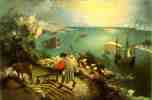Carol Hurst's Children's Literature Newsletter
Volume 2, Number 4. October 1997. Page 2.
Written by Carol Hurst. Edited by Rebecca Otis.
![]()
This issue of the Children's Literature Newsletter is sponsored by:
Carol Hurst, Consultants.
Bringing children's literature to your workshop, conference and classroom.
![]()
Featured Subject: Greek and Roman Mythology
As always, we'll start with a picture book: in this case Jane Yolen's Wings, newly available in paperback (Harcourt, 1997 ISBN 0-15-201567-1. Paperback). In this lovely book the story of Daedalus and Icarus is beautifully told and illustrated. There's a rhythm in the narrative punctuated on each page by a sentence about the gods who watch it all. More background information is included than usual and the picture book serves well as an introduction to a study of many myths.
Staying with this one for the moment, however, we have the Minotaur, monster of the maze, the maze itself, flight, the adolescent rebellion of Icarus, the idea of human reach exceeding its grasp, the jealousy of the gods, the love of Theseus for Ariadne, the thread around Ariadne's waist which would lead them in and out of the maze and the motif of impossible tasks. Any one of these subjects may interest a student and each should be encouraged to take a thread (pardon the pun) and go with it, bringing back to the group any information worth sharing.
The theme of that myth is also taken up in other books such as Lynd Ward's wordless novel, Silver Pony (Houghton, 1973 ISBN 0-395-14753-0 Paperback, Hardcover ) and Chris Van Allsburg's The Wreck of the Zephyr (Houghton ISBN 0-395-33075-0 Hardcover). Both of those books are within reach of younger students and many will see the similarities with the myth.

We can step quickly from Wings into fine arts as there's a wonderful painting by Brueghel entitled "Landscape with the Fall of Icarus" found in many art books and on the web at http://sunsite.unc.edu/wm/paint/auth/bruegel/. The painting shows just the legs of Icarus as he falls unnoticed into the sea near a boat which sails on and next to a plowman intent upon his work. The statement Brueghel makes in the painting is worth speculating upon. Auden's poem on the subject of that particular painting, "Musee des Beaux Arts" can be found in many anthologies and at http://home.ici.net/~ces/poem.html on the web.

Older students, reading it while looking at the painting, may derive more meaning from both. Lois Lowry quoted that poem in her acceptance speech for the Newbery Award for Number the Stars, relating it to the way people went on about their daily lives while horrors such as the Holocaust occurred.
Getting back to mythology, because every myth comes from and leads to another, it may be a good time to set up a database on the computer listing the god, goddess or hero and his or her special skills, domain, and deeds. Include a field for the mother and father of each and the Roman & Greek names. As the theme continues, these entries will help keep the characters straight and serve as both a reporting device and a research tool.

Because many students have trouble relating events and themes in the various myths to their own lives, it may be a good time to share Paul Fleischman's masterful Dateline: Troy (Candlewick ISBN 1-56402-469-5 School & Library Binding). This simple retelling of the Iliad of Homer relates each event to a contemporary news article. Suggest that students do likewise with the myths they investigate for this theme.
Since the myths were part of the oral tradition, most of them make good fodder for storytelling. Set up a story hour and encourage students to participate with an oral rendition of their particular favorite myths.
Many of the myths are allegorical and some students may be ready to see how Venus, the goddess of love and beauty, springing from the foam of the sea can be interpreted as a statement about romance. The various rivers in Hades also have allegorical significance. Relationships between the gods & goddesses also are fraught with meaning: Eris, the goddess of discord, is the sister of Mars, god of war. When Mars walks, the goddesses of terror, trembling and panic walk with him.
Words which derive from the myths make a good vocabulary study. Students can construct a dictionary including such words or devise word games using them. Start them off with atlas, achilles tendon, martial arts, cereal, cloth, morphine, and mortal.
Some other books you'll want to have available are:
- Leonard Everett Fisher's Theseus & the Minotaur (Holiday ISBN 0-8234-0703-9 Paperback,)
- Doris Orgel's Ariadne, Awake! (Viking, ISBN 0-679-85158-2 School & Library Binding)
- David Bellingham's Goddesses, Heroes & Shamans: A Young People's Guide to World Mythology (Kingfisher ISBN 1-85697-999-7 Paperback, Hardcover)
- Rosemary Sutcliff's The Wanderings of Odysseus (Delacorte ISBN 0-385-32205-4 Hardcover)
- Neil Philip's The Adventures of Odysseus (Orchard, 1996 ISBN 0-531-30000-5 Hardcover)
Of course, we haven't touched the history of the civilizations that created these myths but that's another set of themes. Challenge the kids to make the most interesting presentation of their investigations possible. Encourage way-out creativity as well as thorough research and have fun.
Mythology Web Sites:
- Myths and Legends. Links to dozens of good sites:
http://members.bellatlantic.net/~vze33gpz/myth.html
![]()
Go to Next Section of Newsletter, New Book Reviews.
Return to Table of Contents of the Newsletter.
Advertisement:
Advertisement:
Advertisement:

